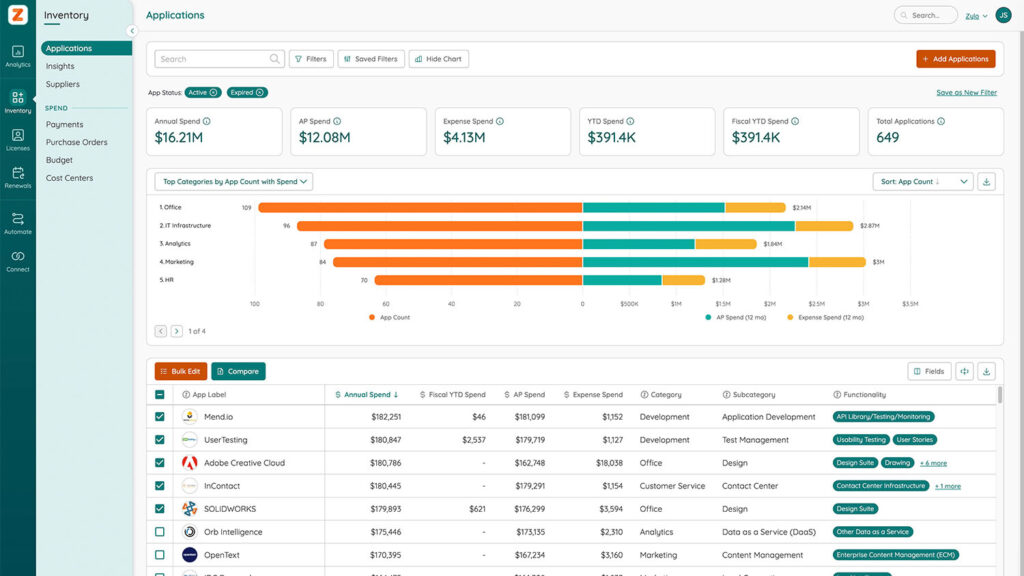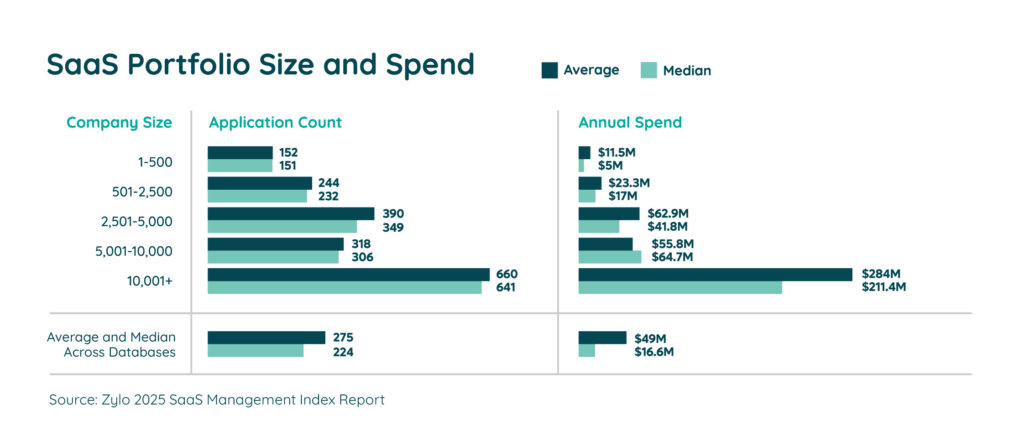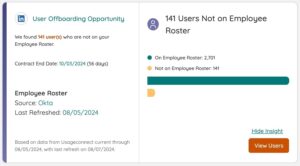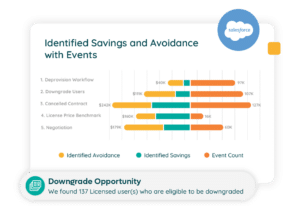Table of Contents
Does getting executive support for SaaS Management feel like an uphill battle? Failure to communicate value and deliver clear and actionable reporting may be putting you at a disadvantage. In fact, executive buy-in and support is one of the most critical foundational elements of a successful SaaS Management program. Following a data storytelling framework can be an essential tool to gaining that support.
At the highest level, you must appeal to your CIO – and sometimes your CFO. When they are aligned and bought in, that’s when SaaS Management becomes a business priority. Support from your CIO and/or CFO fosters better cooperation and strategic alignment, streamlines resource allocation, and spurs stakeholder engagement across the organization.
Let’s explore an effective data storytelling framework for SaaS Management and how to use it. Watch the video below for a quick overview or continue reading.
Benefits of Having Executive Buy-In for SaaS Management
Executives are critical for championing an initiative and helping you overcome potential obstacles. Let’s examine the benefits of executive buy-in for SaaS Management.
Prioritization of SaaS Management
If your c-suite isn’t on the same page, that may result in disjointed efforts toward your strategic objectives. Executive support validates the importance of SaaS Management and its perceived value within the organization. It ensures that SaaS Management is a business priority—not just an IT project.
Importantly, aligning SaaS Management to the company’s strategic business outcomes helps ensure prioritization. We typically see SaaS Management programs drive the following business outcomes:
- Inventory visibility and insights
- Realized, hard cost savings
- Avoidance of unnecessary and preventable costs
- Maintained record of compliance
Engagement & Accountability
Your executive team sets the expectations for the organization. When SaaS Management is a priority at the executive level, stakeholders are more motivated to contribute. It drives cross-functional participation and accountability for realizing outcomes.
Resource Allocation
As you embark on a new initiative, the first question that often comes to mind is, “Do we have the budget and resources to do this right?” When your executive team is bought in and SaaS Management is prioritized, it’s easier to get the funding, tools, and headcount you need to get the job done.
Strategic Decision Making
Because SaaS Management aligns with strategic business goals—like reducing spend, securing the business, and improving efficiency—it increases the importance of strategic decision making. By having support at the executive level, it ensures that your SaaS Management stays aligned to those goals.
Increased Likelihood of Successful Outcomes
When you start something new, you may have a little voice in the back of your mind that says, “What if I fail?” It can be daunting at first, but having executive buy-in reduces your risk of failure—and, actually, improves the likelihood you’ll be successful. Executives ensure teams remain focused on the objectives, help remove potential roadblocks, and drive accountability to results.
The No-BS SaaS Management Playbook
Learn MoreWhat Happens If You Don’t Have Executive Support
What happens if you are unable to secure executive support from the onset of your program? While it may feel like a setback, it’s not necessarily a bad thing.
Instead, start SaaS Management within one organization. IT is often a good starting point, as the team is responsible for overseeing your company’s tech environment. They’re also one of the largest purchasers and deployers of SaaS across the business. As a result, they’re often most in-tune with the problems caused by SaaS.
By focusing your SaaS Management efforts within one organization, you can prove out your program. Get a few wins on the books, hype up that success within your IT org, and then socialize it with other parts of the company. Naturally this will allow SaaS Management to become a bigger enterprise initiative that drives participation and ongoing commitment.
Once you get that executive—and organizational—support, keep this one thing in mind. SaaS Management is a team sport. Don’t let it get siloed within one organization. Expanding program buy-in and support beyond IT will help you drive a broader scope of work across the business.
Data Storytelling Framework for SaaS Management
Data storytelling takes numbers and weaves them into a narrative as a way to distill complex data or information. For SaaS Management, it is crucial for highlighting business issues and how you’re solving them to your executive team. You’re telling a story about the financial, security, and operational risks within your organization and why SaaS Management is important for solving them. More importantly, data storytelling becomes an impactful decision-making tool for driving your SaaS Management strategy.
We recommend following a data storytelling framework that answers these questions:
- What story is the data telling me?
- What does my executive team care about?
- What data is most impactful to my narrative?
- What is the best way to share this data with my executive team?
- How should I build my story around this data?
What story is the data telling me?
Your company’s SaaS metrics are akin to the biometrics your doctor reviews at your annual preventive exam. If your blood pressure is too high, your doctor might recommend lifestyle changes or put you on medication. Likewise, if your SaaS spending is too high, you’ll want to implement measures to contain and reduce it – like establishing purchasing policies or canceling unused applications.
Analyze your data to understand the health of your SaaS Management program and its impact on your organization. Where do you stand today? What changes might be necessary? Additionally, connect the dots between different data points to uncover trends and relationships that might not be immediately obvious.

A common pitfall in data storytelling is not thoroughly understanding the data. If you don’t understand what it means, it’s likely to be misinterpreted. This can result in confusion, misinformed business decisions, or breed mistrust with leadership.
What does my executive team care about?
Your executive team cares most about the organization’s strategic objectives and seeks to understand the broader business impact of your initiatives. That’s in contrast to IT or Procurement professionals who might focus more on tactical details like managing unused licenses or handling SaaS renewals.
To ensure data storytelling that resonates, align your strategic goals and objectives with SaaS Management outcomes. SaaS Management typically supports the following goals:
- Maximizing Software Value: The executive team wants to know that your business is making the most of its software investments. Show them how you’re ensuring full usage of paid tools.
- Reducing Costs and Boosting Revenue: Executives always want to improve the bottom line. Highlight efficiencies that help cut costs and drive growth.
- Strengthening Security: With rising cybersecurity threats, leadership needs to feel confident that you’re minimizing risks through robust security practices.
- Improving Operational Efficiency: Streamlining operations is key to driving efficiency and scaling the business. Explain how SaaS Management is helping teams work smarter, not harder.
- Enhancing Employee Experience: Leaders understand the link between productivity and employee satisfaction. Demonstrate how the right tools improve workflow and engagement.
- Driving Innovation: Staying competitive is crucial. Show how SaaS Management fosters innovation by giving your company access to cutting-edge technologies or freeing up budget to reinvest in the business.
By presenting your SaaS Management efforts in these terms, you can better align with what your executive team cares about and secure their ongoing support.
What data is most impactful to my narrative?
As we just covered, part of data storytelling is about tying SaaS Management to your company-wide objectives. The data you use in this narrative should also tie back to those goals — whether it’s reducing costs, enhancing security, or driving operational efficiencies. Below are a few examples of executive-level metrics:
 Total Number of SaaS Apps: This number reveals and visualizes the extent of SaaS sprawl across your organization. Use it to highlight areas of software redundancy and the effectiveness of software rationalization efforts over time.
Total Number of SaaS Apps: This number reveals and visualizes the extent of SaaS sprawl across your organization. Use it to highlight areas of software redundancy and the effectiveness of software rationalization efforts over time.- Total Annual SaaS Spend: Tracks changes in spending year over year, providing insights into software cost trends and the impact of cost-reduction strategies.
- Unapproved Expensed Apps: The amount spent on software outside of approved channels can indicate unmanaged risks. It can reveal the need for better governance or employee education regarding software purchases. Likewise, a reduction of this metric over time can indicate those measures are working.
- Applications with Multiple Channel Spend: Multiple channel spend means the same software was purchased multiple times through both accounts payable and expense channels. This metric can indicate purchasing inefficiencies and opportunities for consolidation under an enterprise contract for better pricing.
- Cost-Saving Opportunities: Quantify potential savings so you can set realistic targets and monitor actual savings against these goals. This data provides a clear view of the effectiveness of your SaaS spend management efforts.
What is the best way to share this data with my executive team?
Visualizing your data through a SaaS Management executive dashboard is an effective way to communicate with your leadership team. An executive dashboard ensures you present the most relevant and compelling information. It’s a snapshot of critical data, not a deep dive into all the metrics available.
It’s also beneficial to establish a regular cadence for communicating with executives, ideally every quarter. Doing so allows for consistent updates on your program’s progress and showcases the ongoing improvements and value of your initiatives.
Siroui Mushegian, CIO at Barracuda Networks, emphasized the impact of regular updates on SaaSMe Unfiltered. “I would come back every quarter or so and show [the executive team] the first set of nine boxes, the new set of nine boxes, and where we stood, because we would get healthier by the quarter. I was able to show the value of this initiative almost immediately.”
How should I build my story around this data?
To ensure that your executive team is engaged, it’s crucial to align data storytelling with each leader’s interests, focusing on the benefits that resonate most with them.
“It’s always the ‘what’s in it for me’ scenario… You have to find the currency that’s important for each leader that’s going to grab them and make them interested. Dollar signs are really pervasive across all stakeholders,” Mushegian advised.
Structure your story using classic storytelling elements:
- Start with an introduction that sets the scene.
- Present the conflicts or challenges your program faces.
- Conclude with the resolution, detailing the actions you’re taking to address these challenges.
Initially, frame your story around the current state of challenges and your immediate priorities. For regular updates, focus on progress reports and outline the next steps, ensuring that each report reinforces the ongoing value of your SaaS Management efforts.
3 Data Storytelling Examples
Each leader in your organization has different priorities, so the stories you tell should be tailored to what matters most to them. Here are three examples demonstrating effective data storytelling strategies across various executive concerns.
For a deeper dive on each example and why data storytelling is an important skillset, listen to this short, 2-minute podcast clip.
Data Storytelling Example #1: Software Redundancy Is a Barrier to Growing the Business
The average large enterprise (>10k employees) has 660 applications. If you find 2,000 in your inventory, that’s a red flag for SaaS sprawl. Often, a portfolio of this magnitude is riddled with redundancy.

Software redundancy creates data silos, hinders cross-functional collaboration, and results in operational inefficiencies. Together, these factors can create a barrier to business growth.
“When you demonstrate that a plethora of tools fosters silos rather than collaboration, executives quickly see the need to reduce redundancy,” shared Mushegian. “Streamlining tools across teams can significantly enhance scalability and operational efficiency.”
To effectively tell this story, use data points on the total number of SaaS apps and app functions with the most redundancy. While every organization is unique, online training classes, project management, and team collaboration tools often top the list of most redundant functions.
Data Storytelling Example #2: Freeing Up the Budget to Reinvest in the Business
SaaS Management is a key lever to reduce software costs that can be used to reinvest in the business – whether company-wide or departmental initiatives.
Let’s consider your go-to-market (GTM) team – perhaps your COO, CRO, or CMO. At many organizations, the GTM team often has more tools than other business units. As such, there’s often plentiful opportunities to reduce waste and save money.
Use data such as license utilization, cost per user, or departmental spending to show the opportunity for cost optimization. With many budgets under scrutiny these days, your GTM leader will be eager to learn how they can make room in their budget. Doing so can free up resources for headcount expansion, new software purchases, increased digital advertising, and even pay raises or bonuses.
“The story that we’re working on with them is about how we can streamline things so that they have more that they can reinvest into. Maybe they need more headcount in a certain area that they don’t have,” shared Mushegian.
Data Storytelling Example #3: Gaps in SaaS Offboarding Drive Security Risks
Unknown applications translate to unknown risks in your tech environment. But what about the tools you already know about? Failure to properly offboard software for employees who have left the company leave your business with data vulnerabilities.
 If you use Zylo for SaaS Management, you can get insight into gaps in your offboarding process. Highlight what applications and users are the culprit. In your narrative, explain how you’ll ensure proper offboarding occurs going forward.
If you use Zylo for SaaS Management, you can get insight into gaps in your offboarding process. Highlight what applications and users are the culprit. In your narrative, explain how you’ll ensure proper offboarding occurs going forward.
“If I take the what’s in it for me storytelling to [Information Security and Cloud Operations], I say, ‘I’ve got this portfolio of tools you are using, and you probably didn’t realize that half of them have not gone through security review. I didn’t know about them, so when some of your team offboards, I can’t shut down their accounts.’ And immediately, light bulbs go off,” explained Mushegian.
Ready to Tell the Right SaaS Story?
To make data storytelling easier, Zylo centralizes all of your key SaaS data in one platform. It not only streamlines reporting to your executive team, but also helps you secure ongoing support for your SaaS Management program. By using Zylo’s SaaS Management platform, you can simplify reporting, highlight cost-saving opportunities, and address security concerns—all through clear, data-driven storytelling.
Learn more about how Zylo can empower your SaaS strategy here or request a personalized demo with one of our experts to see the impact firsthand.


 Total Number of SaaS Apps
Total Number of SaaS Apps